

USCG CABLE SHIP PEQUOT - UNITED STATES
HARBOR DEFENCES
 |
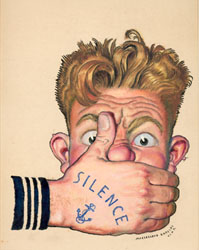 |
 |
 |
The Code of Silence and How "The Pequot" Website Came To Be
This page documents the little-known history of the installation of antisubmarine harbour defences along the eastern coast of the USA during WWII. It focuses on the secret role of the USCG Cableship Pequot and the code of silence maintained by the men aboard her. It also describes how the silence was broken and how the wealth of archival and anecdotal resources have since opened up to researchers Chip Calamaio and Dr Richard Walding - and how international collaboration has brought the story of the Pequot to life. This link USCG Pequot takes you to the main page.
It Was All Very “Hush- Hush”
For years after World War II Chip Calamaio’s father Roger told of the secret mission of the Coast Guard cable ship
he served on as a Gunner’s Mate during WWII. "He’d lower his head, raise his
eyebrows and even after decades speak in a very soft voice as he told me how
very ‘hush hush’ the whole thing was, as he waved his finger back and forth at
me,” his son, Chip, remembers. It was
all top secret,” he’d say cautiously, “and very serious business. You just didn’t
talk about it. Any of it. Period.”
How It Didn’t Work
The way Roger described it, the Pequot
would lay a cable from a shore station “way out into the ocean in a big loop.”
Then “like a finger,” bring it back to land many miles down the coast and “tie
it in” to another shore station. “There would be guys in these little buildings
on each end of the cable,” he explained.
 |
 |
| 5. The Pequot at sea taking care of business. (Mike Luongo) | 6. Roger’s Version of how Loop Cables worked |
“They had all these special instruments in there. They could tell from the metal of the hull when a submarine crossed that cable and could pin point where along that cable the sub was. Then if the station on the other end of the cable picked up the submarine on the opposite side of the loop, they could connect the dots between the two contact locations and figure out the sub’s course heading, and by measuring the time between when the two contacts were made they could determine the sub’s speed. Then they’d send in the destroyers and planes to try to get ‘em,” he claimed.
How Did He Know?
What Roger described doesn’t exactly match
the way we now know indicator loop detection systems actually functioned, with
long narrow double loops of parallel cable connected to a tail cable that ran to
a single shore station, and that they were primarily used for harbor defense
purposes. They were not laid straight out to sea from the shore along the
continental shelf as Roger believed. But what is fascinating is that as just the
ship’s Gunner’s Mate, somehow he’d found out basically what the Pequot was
really up to, and he even used the term “loop”.
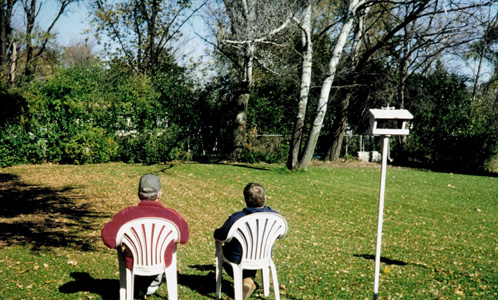 |
|
7. Roger and Chip around 2003 “My Dad was just a great story teller” |
“It just never occurred to me to ask my Dad how he found out about the cable loops or who told him what,” Chip says, “For years I just assumed all the guys aboard the Pequot knew what their mission was, but were told to keep it under wraps.”
Who Really Knew What?
While working on this website every
other Pequot crew member we have been able to locate, and all of the family
members we have contacted so far, tell us they had no idea that the Pequot was
involved in laying secret anti-submarine detection cables. Everyone we have
found believed that they were just putting down and working on standard
telephone and telegraph cables. Even Quartermaster Lou Carhart, whom we have
interviewed at length, claims he had no idea that the cables were anything
secret and he was right up in the wheelhouse with his hands on the ship’s helm
during cable laying operations.
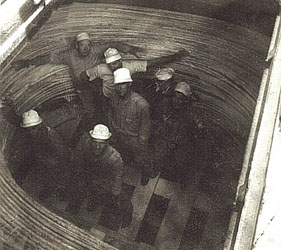 |
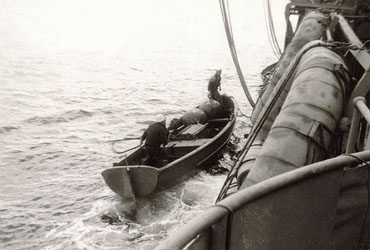 |
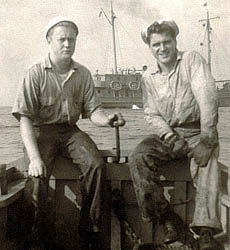 |
| 8, 9, 10. “We were out there for a reason….we didn’t know why” - Lou Carhart. (Photos - Mike Luongo) | ||
And seaman Mike Luongo, who has contributed extensively to this website, told us he had no idea that’s what the cables were used for. Not only was Mike aboard Pequot for 3 years, but he routinely was one of the crew members who helped bring tail cables ashore to the loop huts, in fact, he is one of the sailors in the sequence of photos where we see the Pequot crew using an amphibious DUKW to bring a tail cable ashore at Peaked Hill Bar on the tip of Cape Cod.
 |
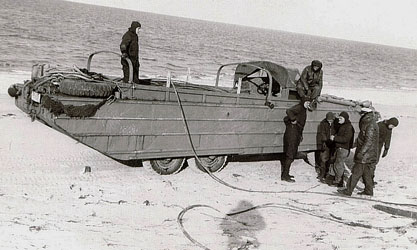 |
|
11, 12. Seaman Mike Luongo laid cables aboard the Pequot for three years during World War II. (Mike Luongo) |
|
But we have to wonder if others knew and just kept the secret.
During WWII Americans were constantly being told of the need for secrecy and security. The Office of War Information, the War Department, private companies, and countless other federal and state agencies were constantly warning of enemy spies and stressing the need for secrecy, particularly as it related to ship movements and U-boat attacks. It is hard to imagine that the Pequot’s Electrician Mates and other specialty ratings who were splicing and repairing loop cables didn’t know their real purpose.
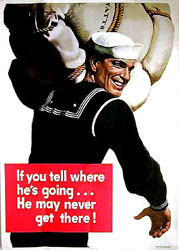 |
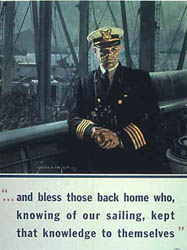 |
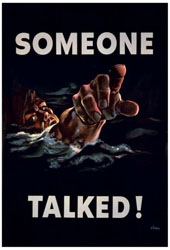 |
 |
|
The intensity of U-boat attacks off East cost shores prompted a major public awareness campaign by the Office of War Information during WWII, especially to keep ship movements secret. |
|||
But in the 1940s, like today, information was compartmentalized and many things were only on a “need to know” basis. For many, the Coast Guard’s code of silence and their patriotism was so deeply ingrained that we can speculate that other Pequot veterans perhaps knew details about the ship’s true mission, but even after decades had passed, they took their knowledge of the U-boat detection loops with them to the grave.
The Initial Inquiry
Even with a Washington DC trip to the
Coast Guard history office, Chip was unable to find any information about the
cables his dad spoke of that were used to detect German U-boats. “In 1991 I was
in DC on business and broke away for a couple of hours and went to the Coast
Guard History Office,” Chip recalls. “At that point in time they had little
information in the Pequot’s file about the ship’s WWII mission since it showed
the Pequot had been transferred over to the Navy during the war. I was told the
Navy might have some records.”
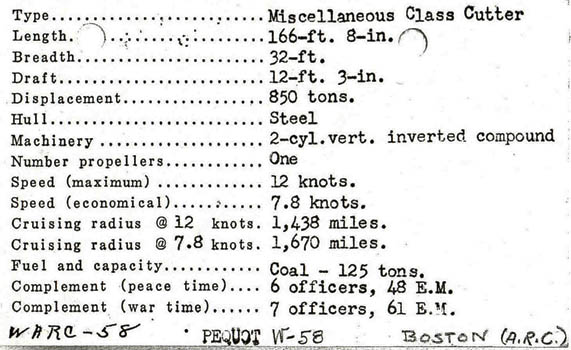 |
|
17. In 1991 all of the Records on Pequot at the USCG History Office were in one thin manila folder including this basic info on the ship which was not entirely accurate since we know Pequot had two propellers. |
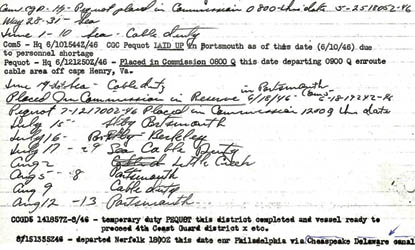 |
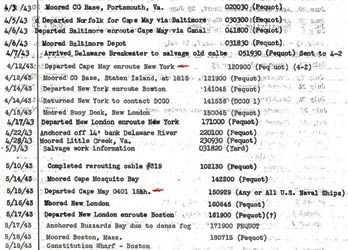 |
|
18, 19. Photocopies of Pequot Radio Logs and Ship Movement Records Gathered in 1991 (Click to enlarge) |
|
“That trip was before the internet, and I just never got back to Washington DC to check with the Navy or to National Archives and try to dig deeper. But I never found any reference to those cables in any book I ever read about the anti-U boat campaign and I never saw it mentioned in any WWII documentaries. I started to wonder if maybe a newer version of that anti-sub technology was still being used during the cold war and maybe it was all still classified.” Chip speculated. “My Dad was known as quite a story teller but he seldom embellished a tale or just made stuff up, so it never occurred to me that he might have had it all wrong. I always believed what he said about the Pequot’s cables.”
A Discovery Down Under
Half a world away, in 1995, physics professor Dr Richard Walding came upon some
cables in the beach sand and an abandoned WWII bunker on Bribie Island along the
East coast of Australia near his home in Brisbane. Richard had walked up that
beach many times, and many times he noticed the grey concrete bunkers on the
beach, with their thin slots for windows. They are the remains of the very
secret antisubmarine harbour defence system from WWII known as an Indicator Loop
control station or officially - the Royal Australian Navy (RAN) No. 4 Station.
His curiosity was sparked by the tangle of rusting cable half-buried in the sand
dunes nearby. How steel and copper cable could detect submarines was a complete
mystery to him until the local library revealed an historical account of the
wartime activities on Bribie Island. What baffled him was why no mention of
indicator loop technology could be found in encyclopedias or on the Internet.
Even the official navy war diary “Australia at War – Royal Australia Navy” had
no mention of loops. The best he could manage was a few lines in the 22 volumes
of the Australian War Memorial’s definitive series “Australia in the War of
1939-1945”. So his research began and he was helped in his quest by Lieut. Syd
Sharp – Officer in Charge of the Bribie Island indicator loop station during the
war; and Lieut. Commander Ron Bagley who was responsible for the technical
training of officers and ratings at the Anti-submarine School HMAS Rushcutter,
Sydney. That lead him to the once-secret indicator loops documents at the
National Archives in Melbourne, Australia; and the National Archives in London.
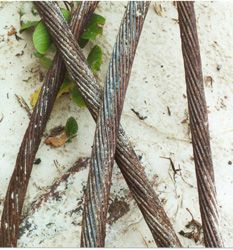 |
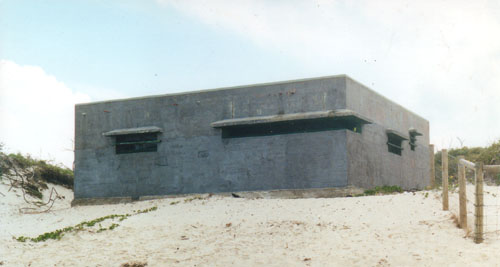 |
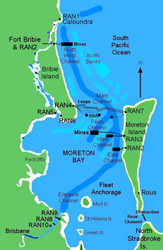 |
| 20. Tail cables in the Australian sand. | 21. The abandoned loop control station on Bribie island, Australia. | 22. Harbor protection at Moreton Bay. Click to enlarge. |
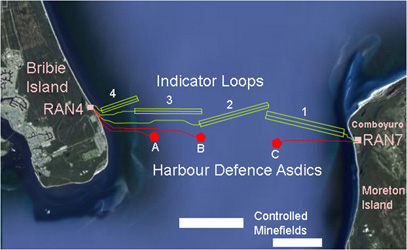 |
 |
| 23. The first four loop positions Richard discovered. | 24. The US Fleet visits Brisbane in
March 1941. (John Oxley Library, State Library of Queensland) |
His investigations soon uncovered the story of “indicator loop” cables laid there in 1943 to protect the port of Moreton Bay, the biggest US submarine base in the Pacific, from Japanese attack.
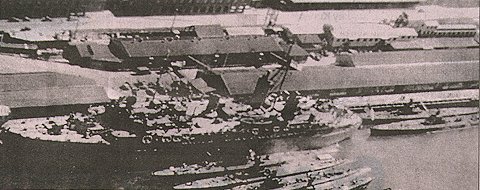 |
 |
| 25. US subs and tender at Capricorn
Wharf, New Farm, Brisbane. (Peter Dunn, Australia At War, ozatwar.com) |
26. USS Fulton (AS-11) with subs at New
Farm, Brisbane. (Peter Dunn, Australia At War, ozatwar.com) |
As a scientist and physics professor Richard became fascinated with this underwater detection system and began his investigations into their history and technology, collaborating with naval historians and enthusiasts from all over the world. He has extensive pages but most notably, the home page at indicatorloops.com/loops.htm
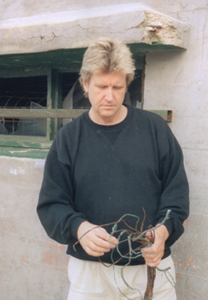 |
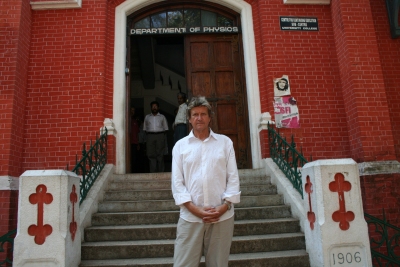 |
| 27. Richard inspecting cables on the coast of Australia. | 28. Richard's research took him to University College, Trivandrum, Kerala, India. |
His research has taken him to locations throughout Australia, and in his pursuit of cable loop history and its technology he has traveled to New Zealand loop locations, and to India where he has researched the work of Professor Alexander Crichton Mitchell who invented the first indicator loop technology for the British Royal Navy around 1915.
It Was All There
In January of 2007 after Richard had put in
12 years of research work on the history of indicator loops and their
development at the close of World War I and their worldwide deployment during
WWII, Chip stumbled upon one of Richard’s numerous websites. “I was just surfing
the web one night and I guess I used the right combination of search words
because suddenly I hit one of Richard’s Indicator Loop websites and suddenly
there it all was...everything my Dad had been talking about for years,
especially all of the locations along the coast of Maine,” Chip recalls. “That
was definitely an “Oh Wow!” moment.”
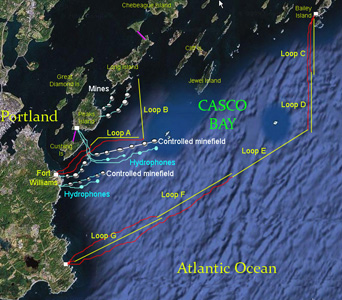 |
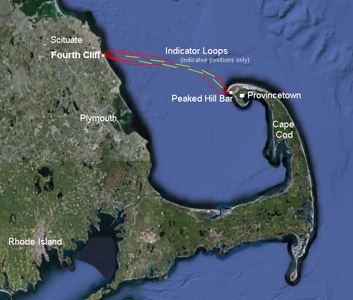 |
|
29, 30. Casco Bay Maine which contained 7 loops installed by the Pequot & the loops protecting Cape Cod Bay |
|
I shot Richard off a quick e-mail explaining that my Dad had been on a Coast Guard ship that had put down those cables and how his website was the first thing I had ever found on indicator loops. It was a bit mind boggling at first since I’d never heard the term “indicator loop” and to discover that it all had been worked up and put together by a professor in Australia.”
A few days later Richard wrote Chip back that, “When I started research in 1995 there was not one word about indicator loops on the internet - it was all in various archives and buried deep. It was highly secret and in many cases had a 50 year embargo. I suspect that because the use of loops died at the end of WW2, the name never reappeared.”
A Unique Collaboration
In the summer of 2009, about 6 months
after Roger Calamaio passed away, Chip started scanning all the pictures in the
old family albums to preserve them in the hope of getting a family history
project started.
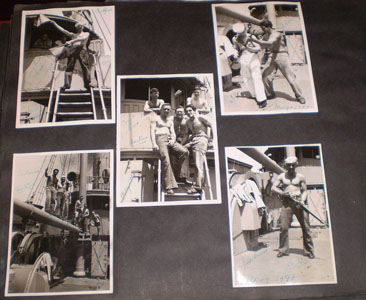 |
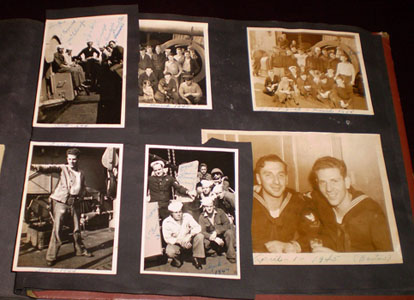 |
|
WWII Coast Guard Pages from Roger Calamaio’s Photo Album |
|
“When I got to about the 3rd album I ran into all of Rog’s WWII and Coast Guard photos. Since I still had the loop pages bookmarked, for fun I e-mailed a few photos of the Pequot to Richard in Australia with a note that perhaps he may want to include a few of those on one of his websites,” Chip remembers. “He sent a nice note of thanks back and wanted to know what other photos I had. I wrote him that my Dad had written all over most of his other Coast Guard photos. He asked me to send him everything I had anyways. So I did and about three days later he surprised me with the first version of the USCG Pequot website. After that things just took off .”
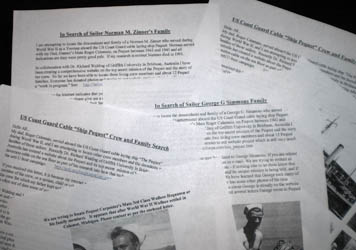 |
 |
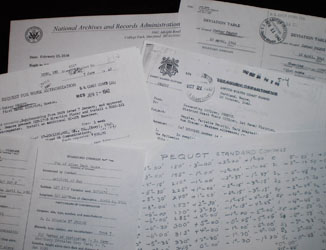 |
| 33. Crew search letters | 34. Catherine Calamaio's WWII Scrapbook | 35. Documents from the National Archives |
Beginning in July of 2009 the two men began a unique long distance collaboration to tell the story of the Pequot. Their extensive research has located a wealth of information on the ship, its mission, and the men who served aboard her. Through on-line inquiry and by mailing out more than 400 search letters, they have located a handful of Pequot veterans and more than 20 families of crew members. “Everyone that we have found has gladly donated photographs, stories, and documents to the project,” Chip explains. “It’s just been fantastic.”
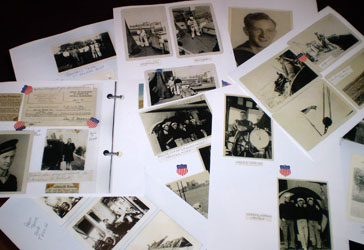 |
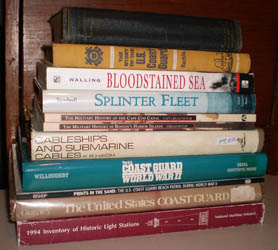 |
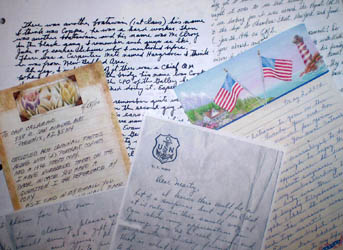 |
| 36. Photos Donation from the Freiermuth Family | 37. Research Sources | 38. Correspondence from Crew & Families |
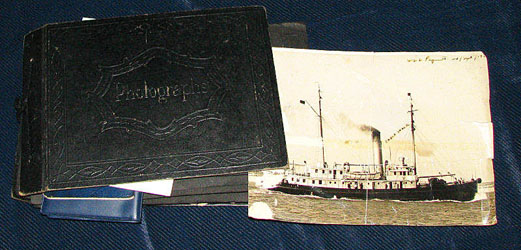 |
 |
| 39. McCormack Family WWII era Photo Album | 40. Note from Chief Yeoman Jim Hudlow August31st 2009 (Click to enlarge) |
“That has been the biggest thrill for me,” Chip says, “to connect with so many people who share this common family history and who now, after more than 65 years, are able to share it with each other. This has become much more than a website about a ship and secret cables, this has become a meeting place for a community of families.”
Richard commented "As I prepare the webpage and read all of the stories over and over again I end up feeling like I know these men. When I hear that one of them has just died it feels like a collaborator has passed away. Chip's perseverance in tracking down all of these men has made a great contribution to our understanding of this little piece of world history".
Chip again: “And even though we have never even met in person, my work with Richard Walding has been one of the most gratifying partnerships I’ve ever enjoyed, and we’ve become damn good friends in the process.” Chip adds. One of these days I’m going to get Down Under and buy my Aussie Pal a pint.”
RADIO INTERVIEW
|
|
On November 13th 2010 Pequot researcher and amateur historian
Chip Calamaio was featured on Wayne Messmer's Homelife Radio
program on Chicago's am560 WIND news-talk radio station as part of a
show to honor the men and women of America's armed forces in conjunction
with the November 11th Veteran's Day holiday. In this fast-paced segment
Chip tells the story of the Pequot website and the ship's secret
mission, the contribution of crew and families to the project, as well
as the spirit of patriotism the tale of the Pequot and its crew has
stirred among many who have visited the website. Courtesy WPM
Productions, am560 WIND radio, Chicago IL, Wayne Messmer and Bob
McAuliff at:
www.homeliferadio.com |
|
Every effort has been made to trace and acknowledge copyright. The
authors would welcome any information from people who believe their photos have
been used without due credit.
Some photos have been retouched to remove
imperfections but otherwise they are true to the original.
FEEDBACK
For comments or questions about indicator loops
in general please contact:
Dr. Richard Walding (Email: waldingr49@yahoo.com.au)
Research Fellow - School of Science,
Griffith University, Brisbane, Queensland, Australia.